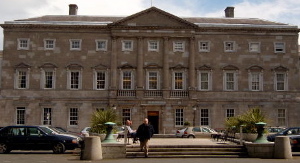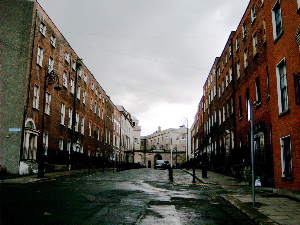Townhouse
|
|

Leinster House
18th century Dublin townhouse of the Duke of Leinster. It is now the seat of parliament.

Henrietta Street
The street contains some of the oldest and largest georgian townhouses in Dublin. All were converted into tenements in the 19th century.
Historically in the United Kingdom, Ireland and in some other countries, a townhouse (or a "house in town") was a residence of a peer or member of the aristocracy in the capital or major city. Most such figures owned one or more country houses in which they lived for much of the year. However during the Social Season (when major balls and drawing rooms took place), and when parliament was in session, peers and the servants moved to live in their townhouse in the capital.
In the United Kingdom and Ireland most townhouses were terraced. Only a small minority of them, generally the largest, were detached, but even aristocrats whose country houses had grounds of hundreds or thousands of acres, often lived in terraced houses in town. For example the Duke of Norfolk owned Arundel Castle in the country, while his London house was a terraced house called Norfolk House in St James's Square - although that particular terraced house was over 100 feet (30 metres) wide. However, the British and Irish architectural term for a house with party walls with its neighbours on both sides was always "terraced house", not townhouse. There was little difference between the more modest terraced townhouses of less opulent members of the aristocracy, and the terraced houses of wealthy middle class Londoners, but they were generally located in different districts.
Many aristocratic townshouses were demolished or ceased to be used for residential purposes following the First World War. In the post World War II period large terraced houses in general in London and other British cities were divided into flats or converted into offices. However, in the early 21st century this trend is being reversed to some extent, as there is less demand for old houses as offices nowadays since open plan layouts are preferred, and the number of very rich people in London has risen. For example, in 2004, the Grosvenor Group sold two grand terraces houses in Belgrave Square which had been in office use, for reconversion to family houses. The asking price was £12 million each.
Nowadays British property developers and estate agents often call new terraced houses townhouses, probably because the aristocratic pedigree of terraced housing is widely forgotten, and for many people the main mental association of terraced housing is with working class terraced housing, especially in poor districts in the north of England. "Townhouse" still has more exclusive connotations.
In North America, the term "townhouse" is used exclusively to refer to terrace housing
See also: duplex, semi-detached, terrace, list of house types
Famous Townhouses
Among the most famous townhouses are:
- 10 Downing Street - the residence of the First Lord of the Treasury (Prime Minister of the United Kingdom)
- 11 Downing Street - the residence of the Second Lord of the Treasury (Chancellor of the Exchequer of the United Kingdom)
- Spencer House - formerly the London residence of the Earls Spencer
- Marlborough House - the residence of the Prince of Wales and later Queen Mary the Queen Mother (1936-1953) (now the Commonwealth Secretariat)
- Clarence House - the residence of the late Queen Elizabeth the Queen Mother and now the residence of Charles, Prince of Wales
- Leinster House - residence of the Duke of Leinster (Ireland's premier duke) and now the seat of Oireachtas Éireann, the Irish parliament.
- Powerscourt House - Dublin residence of Viscount Powersourt, a prominent Irish peer. It was sensitively converted into an award-winning shopping centre in the 1980s. (See an image of one of its decorated ceilings here.)
Georgian Dublin consisted of five georgian squares, which contained the townhouses of prominent peers. The squares were Merrion Square, St. Stephen's Green, Fitzwilliam Square, Ruthland Square (now called Parnell Square) and Mountjoy Square. Many of the townhouses in these squares are now offices while some have been demolished.
Additional Reading
- Daisy, Countess of Fingall, Seventy Years Young (The acclaimed autobiography of an Irish peer's wife, covering the late nineteenth and early twentieth century. Though currently out of print the book is periodically reprinted.)
